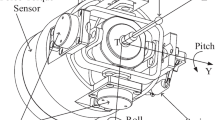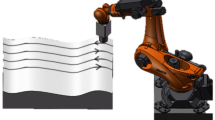Abstract
In this paper, a method of maintaining a constant polishing pressure is proposed for a NC polishing system by controlling the polishing force during the polishing process. First, the NC polishing system is developed to resolve the force–position coupling problem encountered in common polishing processes. It mainly consists of a force control subsystem based on a magnetorheological torque servo to provide a controllable torque to polishing tool to generate the polishing force and a position control subsystem based on a general CNC lathe to control the position of the polishing tool. Second, a constant polishing pressure model is established by controlling the polishing force according to the variation of the curvature of the aspheric surfaces, and the polishing parameters for model are planned. Then, the control model of the polishing system is proposed, and a PID controller is designed for torque tracking with the actual torque feedback from a torque sensor. Finally, polishing experiments are conducted with constant force and constant pressure, respectively. Experimental results show that the surface roughness is greatly improved, the aspheric surfaces can be polished more uniformly with constant pressure than with constant force, and the PID controller can meet the requirements for the polishing force control.
Similar content being viewed by others
Reference
Guvenc L, Srinivasan K (1997) An Overview of robot-assisted die and mold polishing with emphasis on process modeling. J Manuf Syst 16(1):48–58
Lin FY, Lu TS (2005) Development of a robot system for complex surface polishing based on CL data. Int J Adv Manuf Technol 26(9–10):1132–1137
Huissoon JP, Ismail F, Jafari A, Bedi S (2002) Automated Polishing of Die Steel Surfaces. Int J Adv Manuf Technol 19:285–290
Zhao J, Saito K, Kondo T, Narahara H, Igarashi S, Sasaki T, Zhang L (1995) A new method of automatic polishing on curved aluminium alloy surfaces at constant pressure. Int J Mach Tools Manuf 35(12):1605–1728
Furukawa T, Rye DC, Dissanayake MWMG, Barratt AJ (1996) Automated polishing of an unknown three-dimensional surface. Robot Comput-Integr Manuf 12(3):261–270
Wang J, Lu YS, Shu QL, Sun J, Zheng JX (2010) Design and analysis on kinematics of lap-polisher with planet movement for optical fiber end-face. Int J Adv Manuf Technol 50:651–658
Raibert MH, Craig JJ (1981) Hybrid position/force control of manipulators. Trans ASME J Dynam Syst Meas Contr 102:126–133
Hogan N (1985) Impedance control an approach to manipulation (part I-III). Trans ASME J Dynam Syst Meas Contr 107:1–24
Hsu FY, Chen CF (2000) Intelligent robot deburring using adaptive fuzzy hybrid position/force control. IEEE Trans Robotic Automat 16(4):325–335
Lopes A, Almeida F (2008) A force–impedance controlled industrial robot using an active robotic auxiliary device. Robot Comput-Integr Manuf 24:299–309
Nagata F, Hase T, Haga Z, Omoto M, Watanabe K (2009) A desktop NC machine tool with a position/force controller using a fine-velocity pulse converter. Mechatronics 19:671–679
Zhan JM, Yu SH (2011) Study on error compensation of machining force in aspheric surfaces polishing by profile-adaptive hybrid movement-force control. Int J Adv Manuf Technol 54:879–885
Roswell A, Xi F, Liu G (2006) Modelling and analysis of contact stress for automated polishing. Int J Mach Tools Manuf 46:424–435
Lee SN, Lee JI, Kim WB, Yook JG, Kim YJ, Lee SJ (2004) Conductor loss reduction for high frequency transmission lines based on magnetorheological fluid polishing method. Microw Opt Tech lett 42(5):405–407
Cheng HB, Yam Y, Wang YT (2009) Experimentation on MR fluid using a 2-axis wheel tool. J Mater Process Technol 209(12–13):5254–5261
Tsai MJ, Huang JF (2006) Efficient automatic polishing process with a new compliant abrasive tool. Int J Adv Manuf Technol 30:817–827
Liao L, Xi F, Liu KF (2008) Modeling and control of automated polishing/deburring process using a dual-purpose compliant toolhead. Int J Mach Tools Manuf 48:1454–1463
Wang GL, Wang YQ (2009) Research on polishing process of a special polishing machine tool. Machin Sci Technol 13(1):106–121
Liao L, Xi F, Liu KF (2010) Adaptive Control of Pressure Tracking for Polishing Process. ASME Trans- J Manuf Sci Eng 132(1):011015-1–011015-12
Shi YJ, Zheng D, Zhan JM, Wang LS (2010) Design, modeling and testing of torque servo driver based on Magnetorheology[C]. Proc. Internat. Confere. MTMA, Changsha, China, pp 1081–1084
Preston FW (1927) The theory and design of plate glass polishing machines. J Soc Glass Technol 11:214–256
Johnson KL (1985) Contact mechanics. Cambridge University Press, Cambridge
Author information
Authors and Affiliations
Corresponding author
Rights and permissions
About this article
Cite this article
Shi, Y., Zheng, D., Hu, L. et al. NC polishing of aspheric surfaces under control of constant pressure using a magnetorheological torque servo. Int J Adv Manuf Technol 58, 1061–1073 (2012). https://doi.org/10.1007/s00170-011-3445-9
Received:
Accepted:
Published:
Issue Date:
DOI: https://doi.org/10.1007/s00170-011-3445-9




